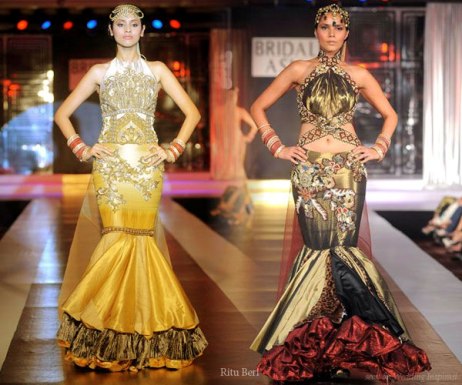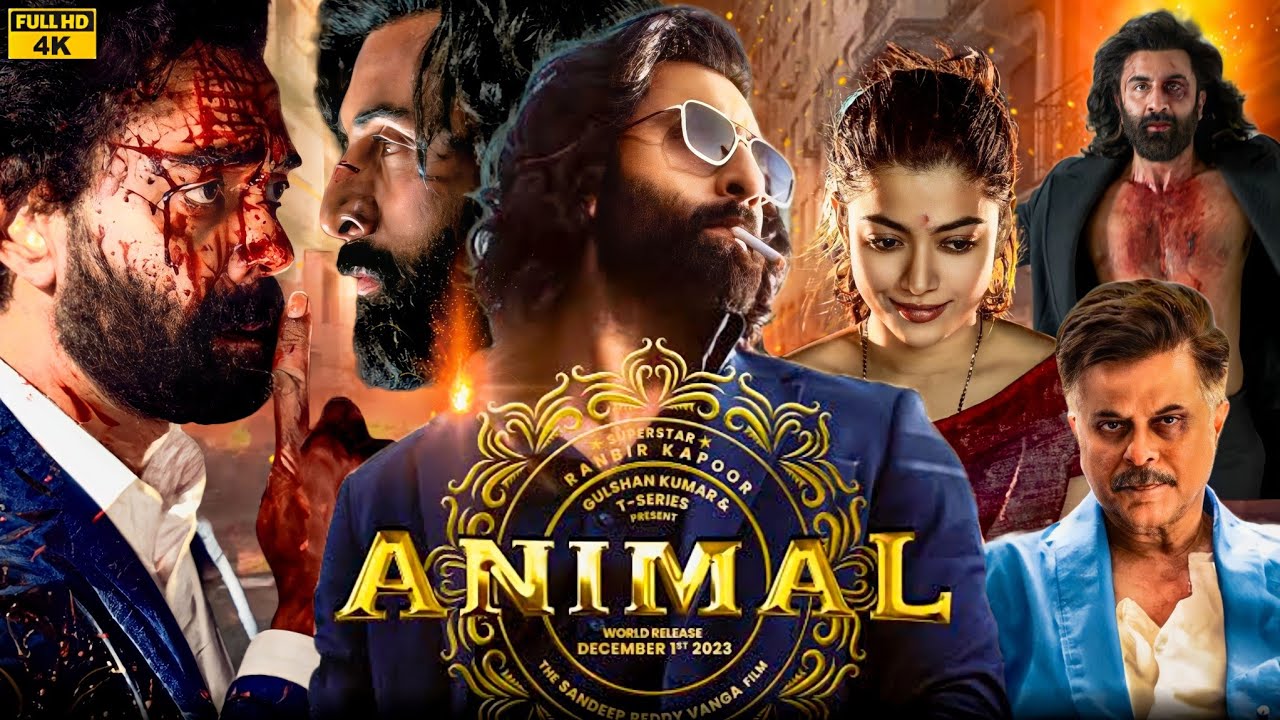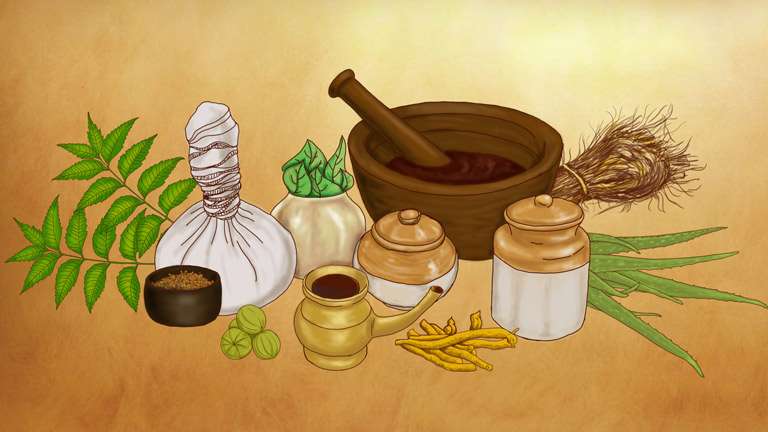Opening up to Kritika Dua, exceptional fashion designer, Ritu Beri, talked about the potential of young designers, growth in the fashion industry, and adaptation of handloom used to produce magnificent designs.
Khadi has been a prominent part of the collections of veteran designer Ritu Beri’s for the last two to three years. Be it conceptualising and designing Vichar Vastra, her first khadi line for KVIC to her latest, A Miscellany in Khadi, her spring/summer 2018 collection that presents the organic fabric in an avant-garde avatar. The collection has indo-western ensembles, a range encompassing both evening wear with a dose of glamour and casual wear which are fuss free, easy to wear and yet stylish. At Ritu Beri Couture, in the serene lanes of Sainik Farm the sheer variety is mind blowing.
There was a red short hemline anarkali with beaded embroidery on the border and paired with a salwar in the same hue. An interesting combination of fuschia pink and parrot green straight kurti with golden embroidery around the neckline along with a sharara was seen. Though some might find the bright combination a bit jarring. The evening wear section had anarkalis (some with slits) with pajami and sharara and a range of colours to opt from — pink, blue, white and shades of red. The casual wear was demure — Indo-western shirt style kurtis with side split and embellished with Indian motifs and flower patchwork in white, maroon, yellow, orange and black. Some even had a sailor vibe to it with patches containing Buoy Yacht in a cool blue shade. What weaved these two segments together was the presence of pockets which we loved! The designer herself was seen sporting the Indo-western shirt style kurti with a side split and a patchwork of her label near the collar which she beautifully paired with wide-legged jeans with frayed hems and accessorize it with pearl earrings and necklace.
How can Indian designers model a concept towards tradition?
India needs to model a concept towards tradition and still be able to cater to what the world demands. Our talented craftsmen, designers and artisans should stop aping the west and develop corporate houses, establish strong brand identities by focusing on niche aspects of Indian culture. A case in point is that of several Japanese designers who have established successful international brand names while respecting the spirit of the Japanese culture in their design. This has enabled them to carve out a niche for themselves in the competitive international world.
India is a real treasure trove of talent, creativity, ideas, passion design, artisans, and craftsmen. It is all about being who we are but definitely respecting the influences of a global presence
When and how did you decide to create an exclusive khadi collection?
Every designer needs a playground to project one’s state of creativity and realise a hyperbolic dream. I indulge in Khadi, which is a luxurious fabric handwoven with hand-spun yarns. A truly organic fabric, I launched my brand 25 years ago with Khadi and have been rigorously using it since last 2-3 years. As Khadi is made with pure cotton or silk yarns, it soothes the skin as it is skin friendly, making it the choice for me.
Khadi production doesn’t leave behind any harmful waste — it is thus the most eco-friendly fabric ever. Khadi is ‘green’, ‘sustainable’, ‘eco-friendly’, ‘zero waste’, ‘biodegradable’, ‘zero carbon footprint’. Embrace Khadi today, has been my motto as a contribution to our planet!
What are the common myths about khadi that need to be debunked?
khadi is only for the summers: Khadi is called an air-conditioned fabric as it is cool in summers and warm in winters.
khadi is old fashioned and only for politicians: Khadi creates a perfect harmony between tradition and modernity. A versatile fabric, it can be used for both western and Indian ensembles.
khadi is high-maintenance: Khadi can easily be hand washed and is durable. Just use a mild detergent to wash and air dry.
khadi is only cotton: Khadi also comes in silk and wool blends and the difference between them is apparent in the texture.
khadi is coarse and crushes easily: Khadi can be very fine, super soft and comfortable. It is considered a luxurious fabric, globally. It crushes not more than any other cotton fabric and looks remarkably fresh almost all day.
khadi was made by mahatma gandhi: Khadi and its existence dates back to 12th century. Gandhi ji advocated the use of the fabric to bring a sense of self-reliance and freedom in the country.
khadi is very expensive: Khadi comes in different varieties and many price ranges. It can be very affordable or expensive — depending on the quality. There is something for every pocket.
khadi is only for day wear: Khadi can create a statement even at night, if tastefully designed and accessorised.
Among all the aspiring young designers, who according to you, has the potential to make it big?
This elegant fabric, Khadi, has found its place in the kitty of designers like Rahul Mishra, Neeru Kumar, Wendell Rodricks and many others who have been experimenting with the fabric in many ways. They have been showcasing beautiful and versatile collections in Khadi over years, thus making it more approachable.
Why should more people be encouraged to adopt handloom and more designers should be encouraged to experiment with it?
To opt for Khadi, therefore, is to emphasise one’s commitment to the spirit of India over appearance, form, character and even over clothing.
Prime Minister Narendra Modi has made a fervent appeal to every Indian to buy khadi and promote the khadi culture, globally. He propagates the concept of khadi as a philosophy, he quoted Mahatma Gandhi who said, “Khadi kewal vastra nahi, ek vichar hai.” (Khadi is not a mere fabric but a serious thought, a concept.)
Khadi, for me, is an effective and powerful symbol of the futility of ‘western imitation’ and there is a need for a revival of local textiles. This gets me back to the idea of ‘khadi’ as more than just a mere cloth. The plus points of Khadi have never been projected well. We are trying to spread awareness of its benefits through recently conceived campaigns.
What are you passionate about apart from fashion?
I am inspired by life in general! I believe that every new day comes with new ideas, aspirations, and dreams.I am a dreamer I enjoy the impossible situation, I put all my effort to bring challenges to reality. My work is greatly influenced by my personal state of mind. I love to explore new possibilities and work in an inspired mode while mostly designing to satisfy myself.
My passion and my dreams drove me to become an entrepreneur. I see myself only as a creative person. As a creative person in business, I follow my own unique creative ways of nurturing my ambition.
Between 1990 and today, what are the big changes you’ve witnessed in the fashion scene in India, and what are the changes you are glad to have happened?
The Indian fashion industry has undergone a tremendous metamorphosis since I joined in 1990. When I started, fashion was only a diversion for the small elite. It was not considered serious business. “Ritual dressing”, was the order of the day, one dressed up for a wedding or a festival.
The Indian fashion scene is seeing interesting times. The economy is opening up and we are making a mark in the international scenario.
The purchasing power of the Indian consumers has indeed escalated, boosted by a healthy economic growth. For them, wants have now become necessities. The marketing pitch is further enhanced by imagery, events, packaging which helps in identification of a real brand.
Today people are more conscious about what they wear. They want to look their best at all times, which is fantastic for us designers.
Our designers are constantly showcasing in various fashion capitals of the world. Indian fashion is spotted on the fashionable ramps of the world and is a huge source of inspiration globally.
The Indian fashion industry is now considered a serious industry even though it is only over 25 years old; we have achieved a lot in this short time.The future and the growth of the fashion industry depends on its outreach and professionalism of the industry and both of which are happening.
What is that one style rule that you vouch for?
Retaining the traditional element of our culture, my collections generally has a modern twist reflecting a global version of the Indian exoticism. My style is intrinsically feminine — romantic with flamboyance. For me, it’s about enhancing a woman’s individuality and persona.
The silhouettes I design are usually a mix of our rich traditional costumes with an exclusive and contemporary look. I enjoy designing clothes that are grand. I design for the fabulous and glamorous woman, the Rock n Roll Woman! My mantra, from the very beginning, is essentially an eclectic blend of East and West.
You have travelled around the world, is there any particular country that scores high on the fashion quotient for you?
Mine is a story of a young Indian fashion designer who dreamt and aspired to conquer the huge global fashion world in Paris. My obsession with Paris and the desire to go beyond the usual is what ventured me on this crazy journey. The city represents the French Capital’s illustrious past. It also stands for the grandest there is in the world of luxury.
For me, it all began with Francois Lesage. Even before I knew him, if a genie popped out and offered me one wish, it would be to hear stories of fashion from the past, in Lesage’s words.
One basic fashion trend you swear by?
Embroideries are a passion for me. I believe that they enlighten clothes immensely. My style is intrinsically feminine, romantic with a flamboyant twist. Being an Indian designer, embroideries have always been an integral part of my collections and they have influenced my collections every season.
Writer: Kritika Dua
Courtesy: The Pioneer








 OpinionExpress.In
OpinionExpress.In















Comments (0)